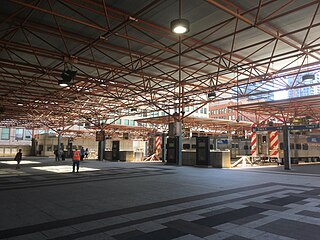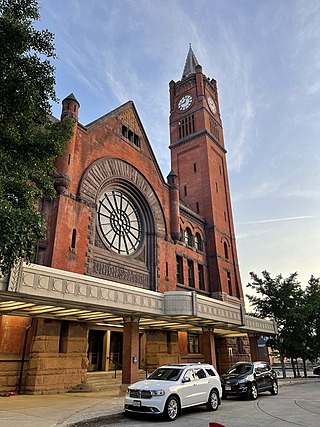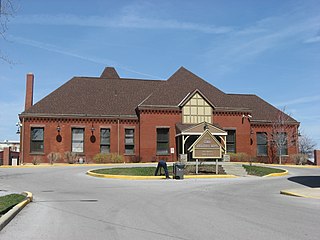
Hobart is a city in Lake County, Indiana, United States. The population was 29,752 at the 2020 census, up from 29,059 in 2010. It has been historically primarily residential, though recent annexation has added a notable retail corridor to the city.

Tower City Center is a large mixed-use facility in Downtown Cleveland, Ohio, on its Public Square. The facility is composed of a number of interconnected office buildings, including Terminal Tower, the Skylight Park mixed-use shopping center, Jack Cleveland Casino, Hotel Cleveland, Chase Financial Plaza, and Tower City station, the main hub of Cleveland's four RTA Rapid Transit lines.
The Lake Erie and Western Railroad was a railroad that operated in Ohio, Indiana and Illinois. The Lake Erie and Western main line extended from Sandusky, Ohio, 412 miles (663 km) westward to Peoria, Illinois, passing through Fremont and Fostoria, Ohio, Muncie and Lafayette, Indiana, and Bloomington, Illinois. It also had main lines extending from Indianapolis to Michigan City, Indiana and from Fort Wayne to Connersville, Indiana. Principal branch lines extended from St. Marys' to Minster, Ohio and from New Castle to Rushville, Indiana.
The Lake Shore and Michigan Southern Railway, established in 1833, and sometimes referred to as the Lake Shore, was a major part of the New York Central Railroad's Water Level Route from Buffalo, New York, to Chicago, Illinois, primarily along the south shore of Lake Erie and across northern Indiana. The line's trackage remains a major rail transportation corridor used by Amtrak passenger trains and several freight lines; in 1998, its ownership was split at Cleveland, Ohio, between CSX Transportation to the east and Norfolk Southern Railway in the west.

The Michigan Central Railroad was originally chartered in 1832 to establish rail service between Detroit, Michigan, and St. Joseph, Michigan. The railroad later operated in the states of Michigan, Indiana, and Illinois in the United States and the province of Ontario in Canada. After about 1867 the railroad was controlled by the New York Central Railroad, which later became part of Penn Central and then Conrail. After the 1998 Conrail breakup, Norfolk Southern Railway now owns much of the former Michigan Central trackage.

LaSalle Street Station is a commuter rail terminal at 414 South LaSalle Street in downtown Chicago. First used as a rail terminal in 1852, it was a major intercity rail terminal for the New York Central Railroad until 1968, and for the Chicago, Rock Island and Pacific Railroad until 1978, but now serves only Metra's Rock Island District. The present structure became the fifth station on the site when its predecessor was demolished in 1981 and replaced by the new station and the One Financial Place tower for the Chicago Stock Exchange. The Chicago Board of Trade Building, Willis Tower, and Harold Washington Library are nearby.
The Pittsburgh, Fort Wayne and Chicago Railway was a major part of the Pennsylvania Railroad system, extending the PRR west from Pittsburgh, Pennsylvania, via Fort Wayne, Indiana, to Chicago, Illinois. It included the current Norfolk Southern-owned Fort Wayne Line east of Crestline, Ohio, to Pittsburgh, and the Fort Wayne Secondary, owned by CSX, from Crestline west to Tolleston in Gary, Indiana. CSX leased its entire portion in 2004 to the Chicago, Fort Wayne and Eastern Railroad (CFE). The remaining portion of the line from Tolleston into Chicago is now part of the Norfolk Southern's Chicago District, with a small portion of the original PFW&C trackage abandoned in favor of the parallel lines of former competitors which are now part of the modern NS system.

The Chicago and Western Indiana Railroad was the owner of Dearborn Station in Chicago and the trackage leading to it. It was owned equally by five of the railroads using it to reach the terminal, and kept those companies from needing their own lines into the city. With the closure of Dearborn Station in 1971 and the Calumet steel mills in 1985, the railroad was gradually downgraded until 1994 when it became a subsidiary of the Union Pacific Corporation.

Nickel Plate Road 765 is a class "S-2" 2-8-4 "Berkshire" type steam locomotive built for the New York, Chicago & St. Louis Railroad, commonly referred to as the "Nickel Plate Road". In 1963, No. 765, renumbered as 767, was donated to the city of Fort Wayne, Indiana, where it sat on display at the Lawton Park, while the real No. 767 was scrapped at Chicago in 1964.

The Indianapolis Union Station is an intercity train station in the Wholesale District of Indianapolis, Indiana. The terminal is served by Amtrak's Cardinal line, passing through Indianapolis three times weekly.

Dyer station is an Amtrak station in Dyer, Indiana, served by the Cardinal route.

The Bowie Railroad Buildings comprise three small frame structures at the former Bowie train station, located at the junction of what is now the Northeast Corridor and the Pope's Creek Subdivision in the town center of Bowie, Maryland. The complex includes a single-story freight depot, a two-story interlocking tower, and an open passenger shed. The station was served by passenger trains from 1872 until 1989, when it was replaced by Bowie State station nearby. The buildings were restored in 1992 as the Bowie Railroad Museum and added to the National Register of Historic Places in 1998.

Union Station is a former union railway station in Gary, Indiana. It is located between the elevated lines of the Lake Shore and Michigan Southern Railway and Baltimore & Ohio Railroad and is just north of the Indiana Toll Road. Indiana Landmarks has placed the building on its 10 Most Endangered Places in Indiana list. The building is listed on the National Register of Historic Places.

Lima station is a historic former train station in Lima, Ohio, United States. Built for the Pennsylvania Railroad in 1887, it is a brick Queen Anne structure that rests on a sandstone foundation. The Lima station is located on the former Pennsylvania Railroad's mainline between New York City and Chicago. Lima station was formerly served by the Pennsylvania Railroad's Pennsylvania Limited and by its flagship Broadway Limited daily passenger trains between New York City and Chicago in its later years.

The Chicago and Northwestern Railroad Depot is a railroad station located between Suffolk and Lowell Streets in Ironwood, Michigan. It was listed on the National Register of Historic Places in 1985.

Chesterton is a disused train station in Chesterton, Indiana. The current depot replaced a wooden structure built in 1852 for the Northern Indiana and Chicago Railroad, a predecessor road of the Lake Shore and Michigan Southern Railway, that burned down in 1913. It was rebuilt in 1914 as a brick structure. By 1914, Cornelius Vanderbilt of the New York Central and Hudson River Railroad held a majority interest in the Lake Shore and Michigan Southern Railway. The Southern Railways trackage provided an ideal extension of the New York Central from Buffalo to Chicago. On December 22, 1914, the New York Central and Hudson River Railroad merged with the Lake Shore and Michigan Southern Railway to form a new New York Central Railroad.

E.J. and E. Griffith Interlocking Tower is a historic interlocking tower located at Griffith, Lake County, Indiana. It was built in 1924 by the Elgin, Joliet and Eastern Railway. It is a three-story, brick building measuring 25 feet long, 16 feet wide, and 30 feet tall. It has a concrete foundation and low pitched hipped roof. The depot operated until 1999. It was moved to its present location in the Griffith Historical Park and Railroad Museum in 2000.

The Union Depot is a railway station located at 610 Western Avenue in Muskegon, Michigan. It was listed on the National Register of Historic Places in 2000. It is now the Muskegon County Convention & Visitor's Bureau.

Union Depot was the name given to two intercity railroad stations in Cleveland, Ohio. Union Depot was built as the first union station in Cleveland in 1853. After a large fire in 1864, a new structure was built, and was the largest train station in the United States until construction of Grand Central Depot in New York City in 1871. The depot was operated by multiple railroads until 1930, when all except the Pennsylvania Railroad dropped their services and utilized Cleveland Union Terminal, which opened that year. The Pennsylvania Railroad continued to use the depot until 1953, and the building was demolished in 1959.




















